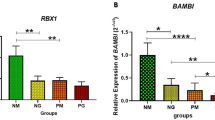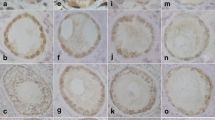Abstract
Purpose
ADAMTS-1 and 9 play a crucial role in the ovulation and their altered levels may play a role in the pathogenesis of polycystic ovary syndrome (PCOS). The aim of this study was to assess ADAMTS-1 and 9 expression and their correlation with the oocyte quality and maturity in the cumulus cells (CCs) of PCOS patients and normovulatory women during an IVF procedure.
Methods
Expression of ADAMTS-1 and 9 and progesterone receptors (PRs) in the CCs containing MII and germinal vesicle (GV) oocytes of 37 PCOS patients and 37 women with normal ovulatory function who underwent IVF treatment was evaluated using qRT-PCR. Moreover, correlation between ADAMTS-1 and 9 expression and oocyte quality were also investigated.
Results
mRNA expression levels of ADAMTS-1 and ADAMTS-9 were significantly reduced in the women with PCOS compared to the normovulatory women. ADAMTS-1 and ADAMTS-9 mRNA expression levels in the CCs showed a considerable correlation. Lower expression levels of ADAMTS-1 and ADAMTS-9 in PCOS patients were strongly correlated with diminished oocyte maturation. There was a remarkable association between ADAMTS-1 and ADAMTS-9 mRNA expression levels and oocyte quality. PRs (PRA and PRB) were dramatically decreased in PCOS patients when compared with the control group.
Conclusions
The results of the present study indicated that ADAMTS-1 and ADAMTS-9 as well as PRs are downregulated in the human CCs in PCOS patients, which could be associated with impaired oocyte maturation and may result in a lower oocyte recovery and oocyte maturity rates, as well as lower fertilization rate.






Similar content being viewed by others
References
Crespo D, Goetz FW, Planas JV (2015) Luteinizing hormone induces ovulation via tumor necrosis factor alpha-dependent increases in prostaglandin F2alpha in a nonmammalian vertebrate. Sci Rep 5:14210. https://doi.org/10.1038/srep14210
Baranova NS, Inforzato A, Briggs DC, Tilakaratna V, Enghild JJ, Thakar D, Milner CM, Day AJ, Richter RP (2014) Incorporation of pentraxin 3 into hyaluronan matrices is tightly regulated and promotes matrix cross-linking. J Biol Chem 289(44):30481–30498
Jeppesen JV, Kristensen SG, Nielsen ME, Humaidan P, Dal Canto M, Fadini R, Schmidt KT, Ernst E, Yding Andersen C (2012) LH-receptor gene expression in human granulosa and cumulus cells from antral and preovulatory follicles. J Clin Endocrinol Metab 97(8):E1524–E1531
Li H, Chian R-C (2017) Follicular development and oocyte growth. In: Development of in vitro maturation for human oocytes. Springer, Berlin, pp 3757
Demircan K, Cömertoğlu İ, Akyol S, Yiğitoğlu BN, Sarıkaya E (2014) A new biological marker candidate in female reproductive system diseases: Matrix metalloproteinase with thrombospondin motifs (ADAMTS). J Turk German Gynecol Assoc 15(4):250
Corbett S, Morin-Papunen L (2013) The polycystic ovary syndrome and recent human evolution. Mol Cell Endocrinol 373(1–2):39–50
Allahbadia GN, Merchant R (2011) Polycystic ovary syndrome and impact on health. Middle East Fertil Soc J 16(1):19–37
Xiao S, Li Y, Li T, Chen M, Xu Y, Wen Y, Zhou C (2014) Evidence for decreased expression of ADAMTS-1 associated with impaired oocyte quality in PCOS patients. J Clin Endocrinol Metab 99(6):E1015–E1021
Huang X, Hao C, Shen X, Zhang Y, Liu X (2013) RUNX2, GPX3 and PTX3 gene expression profiling in cumulus cells are reflective oocyte/embryo competence and potentially reliable predictors of embryo developmental competence in PCOS patients. Reprod Biol Endocrinol 11(1):109
Mattison DR (2015) Computational methods for reproductive and developmental toxicology. CRC Press, Boca Raton
Robker R, Russell D, Espey LL, Lydon J, O'Malley B, Richards J (2000) Progesterone-regulated genes in the ovulation process: ADAMTS-1 and cathepsin L proteases. Proc Natl Acad Sci 97(9):4689–4694
Tang H, Liu Y, Li J, Yin Y, Li G, Chen Y, Li S, Zhang Y, Lin H, Liu X, Cheng CH (2016) Gene knockout of nuclear progesterone receptor provides insights into the regulation of ovulation by LH signaling in zebrafish. Sci Rep 6:28545. https://doi.org/10.1038/srep28545
Russell DL, Brown HM, Dunning KR (2015) ADAMTS proteases in fertility. Matrix Biol 44:54–63
Peluffo MC, Murphy MJ, Talcott Baughman S, Stouffer RL, Hennebold JD (2011) Systematic analysis of protease gene expression in the rhesus macaque ovulatory follicle: metalloproteinase involvement in follicle rupture. Endocrinology 152(10):3963–3974
Mishra B, Koshi K, Kizaki K, Ushizawa K, Takahashi T, Hosoe M, Sato T, Ito A, Hashizume K (2013) Expression of ADAMTS1 mRNA in bovine endometrium and placenta during gestation. Domest Anim Endocrinol 45(1):43–48
Karakose M, Demircan K, Tutal E, Demirci T, Arslan MS, Sahin M, Celik HT, Kazanci F, Karakaya J, Cakal E, Delibasi T (2016) Clinical significance of ADAMTS1, ADAMTS5, ADAMTS9 aggrecanases and IL-17A, IL-23, IL-33 cytokines in polycystic ovary syndrome. J Endocrinol Investig 39(11):1269–1275. https://doi.org/10.1007/s40618-016-0472-2
Tola EN, Koroglu ND, Yalcin SE, Oral HB (2018) The role of serum ADAMTS-1 and aggrecan on polycystic ovary syndrome in adolescents and younger-aged females. Arch Gynecol Obstet 297(2):487–493. https://doi.org/10.1007/s00404-017-4578-3
Group REAsPcw (2004) Revised 2003 consensus on diagnostic criteria and long-term health risks related to polycystic ovary syndrome (PCOS). Hum Reprod 19(1):41–47
Rosewell KL, Al-Alem L, Zakerkish F, McCord L, Akin JW, Chaffin CL, Brännström M, Curry TE (2015) Induction of proteinases in the human preovulatory follicle of the menstrual cycle by human chorionic gonadotropin. Fertil Steril 103(3):826–833
Tsubota K, Kanki M, Noto T, Nakatsuji S, Oishi Y, Matsumoto M, Nakayama H (2015) Altered gene expression profile in ovarian follicle in rats treated with indomethacin and RU486. J Toxicol Sci 40(3):413–425. https://doi.org/10.2131/jts.40.413
Curry TE Jr (2010) ADAMTS1 and versican: partners in ovulation and fertilization. Biol Reprod 83(4):505–506. https://doi.org/10.1095/biolreprod.110.087056
Yung Y, Maman E, Konopnicki S, Cohen B, Brengauz M, Lojkin I, Dal Canto M, Fadini R, Dor J, Hourvitz A (2010) ADAMTS-1: a new human ovulatory gene and a cumulus marker for fertilization capacity. Mol Cell Endocrinol 328(1–2):104–108
Guzman L, Adriaenssens T, Ortega-Hrepich C, Albuz F, Mateizel I, Devroey P, De Vos M, Smitz J (2012) Human antral follicles %3c 6 mm: a comparison between in vivo maturation and in vitro maturation in non-hCG primed cycles using cumulus cell gene expression. MHR Basic Sci Reprod Med 19(1):7–16
Enomoto H, Nelson CM, Somerville RP, Mielke K, Dixon LJ, Powell K, Apte SS (2010) Cooperation of two ADAMTS metalloproteases in closure of the mouse palate identifies a requirement for versican proteolysis in regulating palatal mesenchyme proliferation. Development (Cambridge, England) 137(23):4029–4038. https://doi.org/10.1242/dev.050591
Artimani T, Saidijam M, Aflatoonian R, Amiri I, Ashrafi M, Shabab N, Mohammadpour N, Mehdizadeh M (2015) Estrogen and progesterone receptor subtype expression in granulosa cells from women with polycystic ovary syndrome. Gynecol Endocrinol 31(5):379–383
Akison LK, Boden MJ, Kennaway DJ, Russell DL, Robker RL (2014) Progesterone receptor-dependent regulation of genes in the oviducts of female mice. Physiol Genomics 46(16):583–592. https://doi.org/10.1152/physiolgenomics.00044.2014
Robker RL, Akison LK, Russell DL (2009) Control of oocyte release by progesterone receptor-regulated gene expression. Nucl Recept Signal 7:e012. https://doi.org/10.1621/nrs.07012
Rekawiecki R, Kowalik MK, Kotwica J (2011) Nuclear progesterone receptor isoforms and their functions in the female reproductive tract. Pol J Vet Sci 14(1):149–158
Lima MA, da Silva SV, Freitas VM (2016) Progesterone acts via the progesterone receptor to induce adamts proteases in ovarian cancer cells. J Ovar Res 9:9. https://doi.org/10.1186/s13048-016-0219-x
Willis EL, Bridges PJ, Fortune JE (2017) Progesterone receptor and prostaglandins mediate luteinizing hormone-induced changes in messenger RNAs for ADAMTS proteases in theca cells of bovine periovulatory follicles. Mol Reprod Dev 84(1):55–66. https://doi.org/10.1002/mrd.22761
Acknowledgments
This work was supported by the Research and Technology Deputy of Hamadan University of Medical Sciences (No: 1394.499). We thank the Research Center for Endometrium and Endometriosis and also the Research Center for Molecular Medicine, Hamadan University of Medical Sciences for technical assistance.
Author information
Authors and Affiliations
Contributions
SG project development, IA data collection, SSA data management, MS project development and data management, MY data collection, EK data analysis, NM data collection, NS data collection, TA project development, data management and manuscript writing.
Corresponding author
Ethics declarations
Conflict of Interest
The authors declare that they have no conflict of interest.
Ethical approval
All procedures performed in studies involving human participants were in accordance with the ethical standards of Hamadan University of Medical Sciences Ethics Committee and with the 1964 Helsinki Declaration and its later amendments or comparable ethical standards.
Rights and permissions
About this article
Cite this article
GohariTaban, S., Amiri, I., Soleimani Asl, S. et al. Abnormal expressions of ADAMTS-1, ADAMTS-9 and progesterone receptors are associated with lower oocyte maturation in women with polycystic ovary syndrome. Arch Gynecol Obstet 299, 277–286 (2019). https://doi.org/10.1007/s00404-018-4967-2
Received:
Accepted:
Published:
Issue Date:
DOI: https://doi.org/10.1007/s00404-018-4967-2




